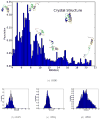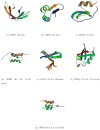Advanced techniques for constrained internal coordinate molecular dynamics
- PMID: 23345138
- PMCID: PMC3835462
- DOI: 10.1002/jcc.23200
Advanced techniques for constrained internal coordinate molecular dynamics
Abstract
Internal coordinate molecular dynamics (ICMD) methods provide a more natural description of a protein by using bond, angle, and torsional coordinates instead of a Cartesian coordinate representation. Freezing high-frequency bonds and angles in the ICMD model gives rise to constrained ICMD (CICMD) models. There are several theoretical aspects that need to be developed to make the CICMD method robust and widely usable. In this article, we have designed a new framework for (1) initializing velocities for nonindependent CICMD coordinates, (2) efficient computation of center of mass velocity during CICMD simulations, (3) using advanced integrators such as Runge-Kutta, Lobatto, and adaptive CVODE for CICMD simulations, and (4) cancelling out the "flying ice cube effect" that sometimes arises in Nosé-Hoover dynamics. The Generalized Newton-Euler Inverse Mass Operator (GNEIMO) method is an implementation of a CICMD method that we have developed to study protein dynamics. GNEIMO allows for a hierarchy of coarse-grained simulation models based on the ability to rigidly constrain any group of atoms. In this article, we perform tests on the Lobatto and Runge-Kutta integrators to determine optimal simulation parameters. We also implement an adaptive coarse-graining tool using the GNEIMO Python interface. This tool enables the secondary structure-guided "freezing and thawing" of degrees of freedom in the molecule on the fly during molecular dynamics simulations and is shown to fold four proteins to their native topologies. With these advancements, we envision the use of the GNEIMO method in protein structure prediction, structure refinement, and in studying domain motion.
Copyright © 2013 Wiley Periodicals, Inc.
Figures








Similar articles
-
Protein structure refinement of CASP target proteins using GNEIMO torsional dynamics method.J Chem Inf Model. 2014 Feb 24;54(2):508-17. doi: 10.1021/ci400484c. Epub 2014 Jan 16. J Chem Inf Model. 2014. PMID: 24397429 Free PMC article.
-
GneimoSim: a modular internal coordinates molecular dynamics simulation package.J Comput Chem. 2014 Dec 5;35(31):2245-55. doi: 10.1002/jcc.23743. Epub 2014 Sep 27. J Comput Chem. 2014. PMID: 25263538 Free PMC article.
-
Internal coordinate molecular dynamics: a foundation for multiscale dynamics.J Phys Chem B. 2015 Jan 29;119(4):1233-42. doi: 10.1021/jp509136y. Epub 2015 Jan 6. J Phys Chem B. 2015. PMID: 25517406 Free PMC article.
-
Coarse-graining methods for computational biology.Annu Rev Biophys. 2013;42:73-93. doi: 10.1146/annurev-biophys-083012-130348. Epub 2013 Feb 28. Annu Rev Biophys. 2013. PMID: 23451897 Review.
-
Coarse-grained force field: general folding theory.Phys Chem Chem Phys. 2011 Oct 14;13(38):16890-901. doi: 10.1039/c1cp20752k. Epub 2011 Jun 3. Phys Chem Chem Phys. 2011. PMID: 21643583 Free PMC article. Review.
Cited by
-
Distinct structural mechanisms determine substrate affinity and kinase activity of protein kinase Cα.J Biol Chem. 2017 Sep 29;292(39):16300-16309. doi: 10.1074/jbc.M117.804781. Epub 2017 Aug 15. J Biol Chem. 2017. PMID: 28821615 Free PMC article.
-
Hamiltonian Monte Carlo with Constrained Molecular Dynamics as Gibbs Sampling.J Chem Theory Comput. 2017 Oct 10;13(10):4649-4659. doi: 10.1021/acs.jctc.7b00570. Epub 2017 Sep 27. J Chem Theory Comput. 2017. PMID: 28892630 Free PMC article.
-
Protein structure refinement of CASP target proteins using GNEIMO torsional dynamics method.J Chem Inf Model. 2014 Feb 24;54(2):508-17. doi: 10.1021/ci400484c. Epub 2014 Jan 16. J Chem Inf Model. 2014. PMID: 24397429 Free PMC article.
-
Overcoming potential energy distortions in constrained internal coordinate molecular dynamics simulations.J Chem Phys. 2016 Jan 28;144(4):044112. doi: 10.1063/1.4939532. J Chem Phys. 2016. PMID: 26827207 Free PMC article.
-
A simple molecular mechanics integrator in mixed rigid body and dihedral angle space.J Chem Phys. 2014 Jul 21;141(3):034105. doi: 10.1063/1.4887339. J Chem Phys. 2014. PMID: 25053299 Free PMC article.
References
-
- Mazur A, RA A. J Biomol Struct Dyn. 1989;6:815. - PubMed
-
- Mazur AK, Dorofeev VE, Abagyan RA. J Comput Phys. 1991;92:261.
-
- Jain A, Vaidehi N, Rodriguez G. J Comput Phys. 1993;106:258.
-
- Chen J, Im W, Brooks CL., III J Comput Chem. 2005;26:1565. - PubMed
-
- Gibson KD, Scheraga HA. J Comput Chem. 1990;11:468.
Publication types
MeSH terms
Substances
Grants and funding
LinkOut - more resources
Full Text Sources
Other Literature Sources

